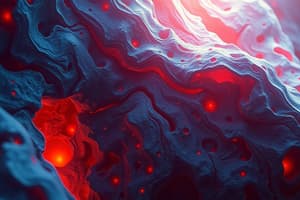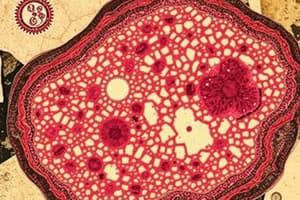Podcast
Questions and Answers
What is the main function of bone tissue?
What is the main function of bone tissue?
- Production of hormones
- Reservoir for minerals (correct)
- Providing insulation
- Gas exchange
Which type of cartilage is known for its strength and durability?
Which type of cartilage is known for its strength and durability?
- Elastic cartilage
- Fibrocartilage (correct)
- Articular cartilage
- Hyaline cartilage
How is nutrition supplied to chondrocytes in cartilage?
How is nutrition supplied to chondrocytes in cartilage?
- By diffusion of gases
- Through diffusion from the matrix (correct)
- Via lymphatic vessels
- Through direct blood supply
Which type of muscle tissue is described as striated and voluntary?
Which type of muscle tissue is described as striated and voluntary?
What characteristic best describes nervous tissue?
What characteristic best describes nervous tissue?
What is the primary role of blood as a tissue?
What is the primary role of blood as a tissue?
Which type of connective tissue forms the dense fibrous tissues?
Which type of connective tissue forms the dense fibrous tissues?
Which of the following membranes covers visceral organs?
Which of the following membranes covers visceral organs?
What term describes the growth of new tissue after damage?
What term describes the growth of new tissue after damage?
What type of tissue has the greatest ability to regenerate?
What type of tissue has the greatest ability to regenerate?
Which type of epithelial tissue consists of multiple layers of flat cells filled with keratin?
Which type of epithelial tissue consists of multiple layers of flat cells filled with keratin?
What is the primary function of glandular epithelium?
What is the primary function of glandular epithelium?
Which type of connective tissue serves primarily as a food reserve and provides insulation?
Which type of connective tissue serves primarily as a food reserve and provides insulation?
Which classification of epithelial tissue lines hollow viscera and is subject to stress?
Which classification of epithelial tissue lines hollow viscera and is subject to stress?
What characteristic differentiates merocrine glands from apocrine and holocrine glands?
What characteristic differentiates merocrine glands from apocrine and holocrine glands?
Which component of the extracellular matrix plays a crucial role in binding tissues together?
Which component of the extracellular matrix plays a crucial role in binding tissues together?
Which type of connective tissue is primarily characterized by its fluid matrix?
Which type of connective tissue is primarily characterized by its fluid matrix?
Which primary germ layer develops into muscle tissue?
Which primary germ layer develops into muscle tissue?
What is a key feature of membranous epithelium?
What is a key feature of membranous epithelium?
Which type of fibrous connective tissue provides stretch and flexibility?
Which type of fibrous connective tissue provides stretch and flexibility?
Flashcards
Epithelial tissue
Epithelial tissue
A type of tissue that covers the body and its parts, lines cavities, and forms glands.
Connective tissue
Connective tissue
Connects, supports, transports, and protects other tissues. It is composed of cells scattered within an extensive extracellular matrix.
Histogenesis
Histogenesis
The process of primary germ layers differentiating and grouping together to form different types of tissue.
Endoderm
Endoderm
Signup and view all the flashcards
Mesoderm
Mesoderm
Signup and view all the flashcards
Ectoderm
Ectoderm
Signup and view all the flashcards
Endocrine glands
Endocrine glands
Signup and view all the flashcards
Exocrine glands
Exocrine glands
Signup and view all the flashcards
Adipose tissue
Adipose tissue
Signup and view all the flashcards
Cartilage
Cartilage
Signup and view all the flashcards
Bone tissue
Bone tissue
Signup and view all the flashcards
Ossification
Ossification
Signup and view all the flashcards
Blood
Blood
Signup and view all the flashcards
Hematopoiesis
Hematopoiesis
Signup and view all the flashcards
Skeletal muscle
Skeletal muscle
Signup and view all the flashcards
Smooth muscle
Smooth muscle
Signup and view all the flashcards
Cardiac muscle
Cardiac muscle
Signup and view all the flashcards
Nervous tissue
Nervous tissue
Signup and view all the flashcards
Tissue repair
Tissue repair
Signup and view all the flashcards
Study Notes
Principles of Tissue
- Epithelial tissue, muscle tissue, nervous tissue, and connective tissue are the primary tissue types.
- Embryonic development includes the layers: endoderm, mesoderm, and ectoderm.
- Histogenesis is the process of primary germ layers differentiating into different tissues.
- Extracellular matrix is the non-living material between cells in a tissue. Key components include water, proteins, glycoproteins, proteoglycans, and polysaccharides.
- The extracellular matrix helps tissues bind together structurally and allows cellular communication through connections with integrins and the plasma membrane.
Epithelial Tissue
- Epithelial tissue is divided into membranous (covering or lining) and glandular epithelium.
- Membranous epithelium lines or covers body surfaces and cavities like serous cavities and the respiratory, digestive, and genitourinary tracts.
- Glandular epithelium consists of secretory units of endocrine or exocrine glands, producing materials.
Classification of Membranous Epithelial Tissue
- Squamous (flat), cuboidal, columnar, and pseudostratified columnar are types.
- Simple squamous, simple cuboidal, simple columnar, pseudostratified columnar, stratified squamous (with or without keratin), stratified cuboidal, and stratified columnar.
- Transitional epithelium lines hollow organs subjected to stress
Glandular Epithelium
- Specialized in secretory activities.
- Exocrine glands discharge secretions into ducts.
- Endocrine glands, also called ductless glands, discharge secretions directly into the blood or interstitial fluid
Functional Classification of Exocrine Glands
- Apocrine glands: secretion products collect near the apex of the cell and are secreted via pinching off of the cell's end (e.g., mammary glands)
- Holocrine glands: cells need to break apart to complete function (e.g., sebaceous glands)
- Merocrine glands have ducts (most numerous)
Connective Tissue
- Connective tissue functions in support, protection, transportation, and general functions.
- Connective tissue types include fibrous (loose, areolar, adipose, reticular), dense (irregular, regular), bones, cartilage (hyaline, fibrocartilage, elastic), and blood(fibrous connective tissue).
Bone Tissue
- Bone tissue is a uniquely hard and strong connective tissue, providing support, protection, attachment sites for muscles, and mineral storage.
Cartilage Tissue
- Cartilage tissue is composed of chondrocytes, is avascular, and nutrients diffuse through the matrix.
- Hyaline, fibrocartilage, and elastic are main types.
Blood Tissue
- A liquid tissue that transports substances, regulates body temperature, and regulates body pH. It contains neither ground substance nor fibers.
Muscle Tissue
- Muscle tissue types: skeletal (voluntary), smooth (involuntary), and cardiac (involuntary).
Nervous Tissue
- Nervous tissue functions in rapid regulation and integration of body activities and comprises neurons, conducting units of the system.
Tissue Repair
- Tissue repair depends on the tissue type (epithelial and connective regenerate better). Muscle and nervous tissue regenerate less effectively.
Body Membranes
- Thin tissue layers that cover surfaces, line cavities, divide spaces, and/or surround organs.
- Types include cutaneous (skin), serous, and mucous.
- Synovial membranes line joint cavities and produce synovial fluid to reduce friction.
Studying That Suits You
Use AI to generate personalized quizzes and flashcards to suit your learning preferences.




